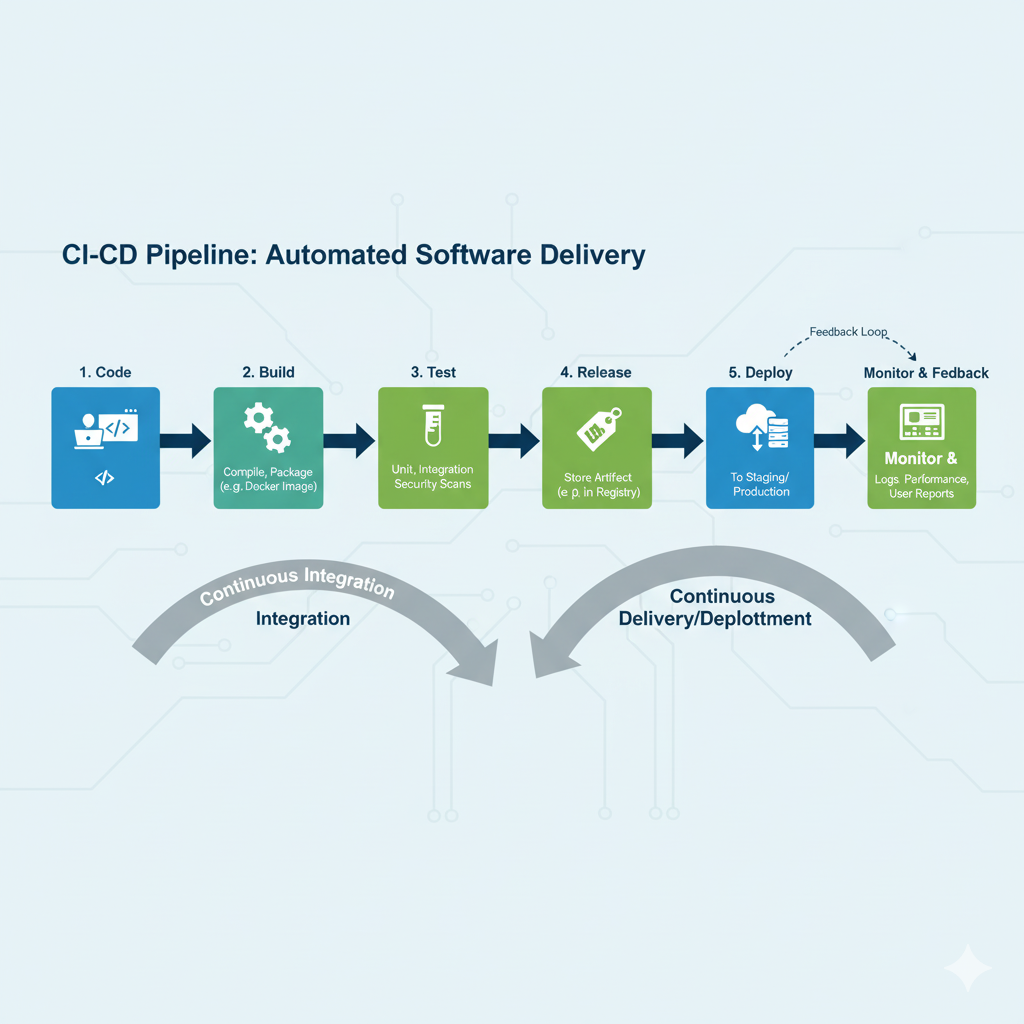CI/CD Pipelines
Modern engineering teams ship code fast and reliably thanks to CI/CD pipelines. These pipelines automate the journey from developer commit → tests → build → deployment, ensuring that software reaches users quickly without compromising on quality. For distributed systems and microservices, CI/CD becomes even more critical: it keeps services aligned, reduces manual toil, and ensures resilience.

1. Why CI/CD Pipelines Matter
- Speed: Push code to production multiple times a day without fear.
- Quality: Automated tests catch bugs early.
- Reliability: Rollbacks and staged deployments reduce downtime.
- Scalability: In microservices, pipelines scale with the number of services.
- Culture: CI/CD is at the heart of DevOps — shifting teams toward automation-first practices.
Case study:
- Amazon pioneered automated deployment pipelines to support thousands of microservices, enabling “You build it, you run it.”
- Google uses CI/CD at massive scale with Borg and later Kubernetes, proving reliability at planetary scale.
- Meta pushes code thousands of times per day with staged rollouts and monitoring baked in.
2. Continuous Integration (CI)
Definition: Automatically build and test every change to ensure that code integrates cleanly.
Key steps:
- Commit → developers push code.
- Build → code compiled, dependencies installed.
- Test → unit/integration tests run automatically.
- Artifact → a build artifact (e.g., JAR, Docker image) is created.
Benefits:
- Detects integration issues early.
- Keeps the main branch deployable.
- Encourages small, frequent commits.
3. Continuous Deployment (CD)
Definition: Automatically deploy validated builds to staging or production environments.
Techniques:
- Blue/Green Deployment → run two environments, flip traffic gradually.
- Canary Release → send a small % of traffic to the new version before full rollout.
- Rolling Update → replace pods or VMs gradually.
- Rollback → revert automatically if errors spike.
Benefits:
- Reduce human error.
- Minimize downtime.
- Deliver features faster.
4. CI/CD Workflow (End-to-End)
- Developer pushes code → triggers pipeline.
- Pipeline builds & runs automated tests.
- Application is containerized (Docker).
- Image is pushed to a registry.
- Deployment manifests (Kubernetes, Terraform) applied.
- Monitoring/alerts verify success.
- If metrics fail → rollback triggered.
Think of it as: Commit → Build → Test → Package → Deploy → Monitor.
5. Pitfalls of CI/CD
- Over-complex pipelines → fragile YAML spaghetti.
- Slow builds/tests → developers skip CI if it takes >30 minutes.
- Weak rollback strategy → teams panic when deploys fail.
- Insufficient observability → deploys succeed but silent bugs leak to production.
- One pipeline fits all → ignoring microservice-specific needs leads to bottlenecks.
Case study:
- Etsy once had long, brittle deploy cycles; they invested in CI/CD and now ship dozens of times per day.
- Netflix developed Spinnaker to solve pipeline scale issues for microservices.
6. Best Practices
- Keep pipelines fast → parallelize builds/tests.
- Shift-left testing → run unit & integration tests before merge.
- Use Infrastructure as Code (IaC) → pipelines should provision infra automatically.
- Automated rollback → every production deploy must be reversible.
- Security checks → add dependency scanning & secrets detection to the pipeline.
- Observability baked-in → monitor deployment metrics automatically.
- Environment parity → dev/staging/prod should be identical via containers.
7. CI/CD Example with GitHub Actions
Pipeline (.github/workflows/cicd.yml)
name: CI/CD Pipeline
on:
push:
branches: [ main ]
jobs:
build-test-deploy:
runs-on: ubuntu-latest
steps:
- uses: actions/checkout@v3
- name: Set up JDK 17
uses: actions/setup-java@v3
with:
java-version: '17'
distribution: 'temurin'
- name: Build & test
run: mvn clean verify
- name: Build Docker image
run: docker build -t my-app:${{ github.sha }} .
- name: Push to Docker Hub
run: |
echo "${{ secrets.DOCKER_PASSWORD }}" | docker login -u ${{ secrets.DOCKER_USERNAME }} --password-stdin
docker push my-app:${{ github.sha }}
- name: Deploy to Kubernetes
run: kubectl apply -f k8s/deployment.yamlSample Java Microservice
import org.springframework.boot.*;
import org.springframework.boot.autoconfigure.*;
import org.springframework.web.bind.annotation.*;
@SpringBootApplication
public class App {
public static void main(String[] args) {
SpringApplication.run(App.class, args);
}
}
@RestController
class HealthController {
@GetMapping("/health")
public String health() { return "Healthy"; }
}8. Interview Preparation
What to highlight:
- Pipeline stages: CI (build, test), CD (deploy, monitor).
- Resilience: rollbacks, canary, observability.
- Scaling pipelines: 1 → 100s of microservices.
- Tradeoffs: GitHub Actions for simplicity vs. Jenkins/Spinnaker for flexibility.
Example 2-sentence answer:
“I’d design a CI/CD pipeline with GitHub Actions that builds, tests, and containerizes the app, then deploys to Kubernetes with a canary rollout. If metrics degrade, the pipeline automatically rolls back.”
9. Quick Reference
- Books: Continuous Delivery (Humble & Farley).
- Tools: GitHub Actions, Jenkins, Spinnaker, ArgoCD.
- Patterns: Blue/Green, Canary, Rolling updates.
10. Final Notes
CI/CD is not just tooling — it’s culture, speed, and safety combined. Whether in interviews or real-world projects, show that you can:
- explain the workflow,
- call out pitfalls,
- and design resilient pipelines.
That’s the difference between “deploys work” and “deploys scale.”
Next: Security in Infra: Fraud Prevention.